After the first
successful attempt of MPASC hosting the Melaka Space Fair 2010 from the 22nd
– 29th November 2010, the prestigious event is back this year with
even more fun-filled science activities this coming 5th – 11th
November, 2012.
Melaka Space Fair 2012, for the
serious science part will have a focus on robotics exploration, a tale of the
year of the solar system, planetary sciences through GLOBE, Astrobiology
featuring Microbial life in the extreme environment and the success story of
NASA Spin Offs in enhancing our quality of lives. For the crazy fun part, MPASC
has for you DIY Comet, 15 minute Egg Drop Challenge, Crazy Foam and many more.
Similar to 2010, 10 of NASA
professionals ranging from space mission scientists, engineers and STEM (Science,
technology, Engineering, Mathematics) educator will be here at MPASC where
members of the public would be able to meet and share experiences.
MPASC team is meticulously
planning the Melaka Space Fair 2012 to ensure the smooth flow of the 1 week
event this coming November. Activities are being revised to maximize impact on
visitors particularly students and educators.
Follow our ‘BLOG” for latest
updates on the Melaka Space Fair 2012. Should you have inquiries on the event, drop
a call to Ms. Bavani Sri Nagappan (MPASC Technical and Operation Executive) at
+606 232 2424 or +606 232 2122
*****************************
Management Team
Melaka Planetarium Adventure Science Centre































